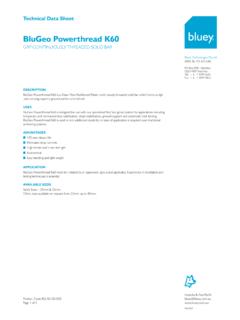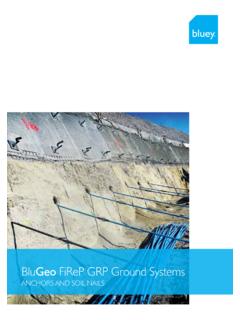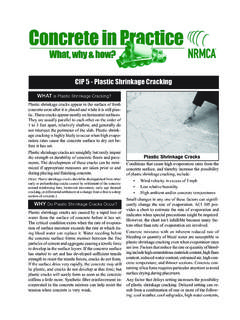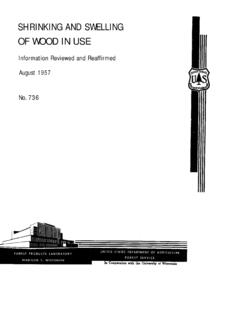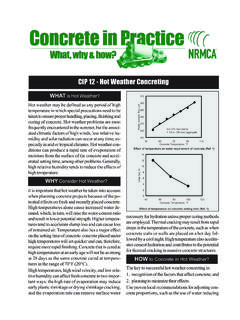Transcription of Evaluating Cracking in Concrete - Bluey Technologies
1 Evaluating Cracking in ConcretePROCEDURES2 Bluey TechnologiesEvaluating Cracking In Concrete PROCEDURESWHY CRACKS FORM IN Concrete STRUCTURESC oncrete provides structures with strength, rigidity, and resilience from deformation. These characteristics, however, result in Concrete structures lacking the flexibility to move in response to environmental or volume changes. Cracking is usually the first sign of distress in Concrete . It is, however, possible for deterioration to exist before cracks appear. Cracking can occur in both hardened and fresh, or plastic, Concrete as a result of volume changes and repeated loading. This involves tensile stresses being loaded onto the Concrete , the cracks occurring when the force exceeds its maximum tensile strength. We at Bluey Technologies maintain that it is important to understand the reasons why Cracking occurs, the type of crack formed, and cracks effects on structural stability. Once you understand these points you can take the appropriate action.
2 This may mean leaving the crack alone, injecting the crack with an appropriate material, or applying other suitable repair CRACKS CAUSES AND S TAT U S It is important to identify the primary concern in regard to any Cracking . The main concerns are whether the cracks are affecting structural integrity, caused by inappropriate design, aesthetically unacceptable, or reducing durability. You can only identify the primary concern after Evaluating a crack thoroughly. IMPORTANT POINTS TO EVALUATEThe type of Cracking provides useful information to help understand a crack s effects on structural stability. Figure 1 presents a summary of the different types of Concrete cracks and their possible crack s status is critically important. Active cracks may require more complex repair procedures that may include eliminating the actual cause of the Cracking in order to ensure a successful long-term repair. Failure to address the underlying cause may result in the crack s repair being short-term, making it necessary to go through the same process again.
3 Dormant cracks are those not threatening a structure s stability, but those responsible for the structure must address durability issues and take appropriate action if aesthetics are a priority. A crack s environmental conditions influence the extent to which it affects its structure s integrity. Greater exposure to aggressive conditions increases the possibility of structural instability. Cracks sizes range from micro-cracks that expose the Concrete to efflorescence to larger cracks caused by external loading conditions. Noting cracks sizes, shapes, and locations can aid in determining their initial causes. Figure 2 illustrates the types of cracks and their primary causes in relation to their 1: Types of cracks and their causesCRACKING IN PLASTIC CONCRETEC racks that form in plastic Concrete can be categorised as either plastic shrinkage Cracking or plastic settlement Cracking . Both of these types result from the bleeding and segregation process that occurs when fresh Concrete is placed.
4 Such cracks usually appear from one to six hours after Concrete placement. 3 Evaluating Cracking in ConcreteEvaluating Cracking In Concrete PROCEDURESTYPES OF CRACKSAFTER HARDENINGPHYSICALS hrinkable aggregatesDrying shrinkageCrazingCHEMICALC orrosion of reinforcementAlkali-aggregate reactionsCement carbonation shrinkageTHERMALF reeze/thaws cyclesExternal seasonal temperature variationsEarly thermal contradictionExternal restraintInternal temperature gradientsSTRUCTURALA ccidental overloadCreepDesign loadsTYPES OF CRACKSBEFORE HARDENINGE arly frost damagePLASTICP lastic shrinkagePlastic settlementCONSTRUCTIONAL MOVEMENTF ormwork movementSub-grade movementFigure 1: Types of cracks and their causes4 Bluey TechnologiesEvaluating Cracking In Concrete PROCEDURESPLASTIC shrinkage CRACKINGAs the Concrete s heavier particles settle due to gravity, they push the water and lighter particles toward the surface. This is called bleeding. If you fail to monitor the temperature, wind, and humidity conditions properly the evaporation rate of the surface water may exceed the bleed rate, drying out the Concrete s superficial layer and therefore shrinking it due to dehydration.
5 The Concrete beneath the surface layer is still well hydrated, however, and maintains its volume. This applies opposing tensile forces to the lower part of the drying Concrete on the surface, causing a cracked Concrete profile. These plastic shrinkage cracks are usually shallow and only from 1 to 2 mm in width, which means you cannot repair them with the injection method. They may, however, self-heal through continual cement hydration or by the precipitation of calcium carbonate from the the cracks are wider than 2 mm and do not self-heal, it is important that you repair them with a suitable coating or flood-grouting product to stop them from penetrating the full depth of the Concrete slab. If they do become active their reaction to stresses may result in further Cracking that weakens the structure either directly or by exposing its reinforcement steel to contaminants that will in time corrode it. PLASTIC SETTLEMENT CRACKINGThe settlement process is a major factor in Concrete s strength at different levels as it forms.
6 Plastic settlement Cracking can occur as a result of such restraints to the consolidation of the fresh Concrete as the use of steel reinforcing bars or 2 illustrates how plastic settlement cracks form. As the Concrete bleeds, the water works its way to the surface. Sedimentation then occurs as the aggregate and cement move downwards under the force of gravity. This separation forms a weaker layer of Concrete near the surface. If such restraints as steel reinforcing bars are close to the surface and insufficiently covered with Concrete the Concrete bends back around the restraint and cracks at the apex. Deeper sections of Concrete lead to greater separation between the sediment and the water, so it is important to ensure that you cover all superficial restraints adequately to reduce the amount of Evaluating Cracking in ConcreteFigure 2: Schematic representation of plastic settlement crack formationPlastic settlement cracks may also occur in forms involving a sudden change in the Concrete s depth, as it settles more in the deep sections than the shallow ones, forcing Cracking at the point of change.
7 A good example of this is waffle troughs, in which the depth changes constantly across the length of the form. DRYING SHRINKAGEThis is the main cause of Cracking in hardened Concrete . This Cracking takes place near the restraints due to volume changes in the Concrete . When Concrete is exposed to moisture it swells and when it is exposed to air with relatively low humidity it shrinks, such air drawing water out of its cement paste, which is cement and water. If the shrinkage could occur without restraint no Cracking would result, but in most cases the requirements of structural support makes this impossible. This Cracking is the result of a combination of factors that influence the magnitude of the tensile stresses that cause it. These factors include the amount and rate of shrinkage , the degree of restraint, the modulus of elasticity, and the amount of creep. Additional Evaluating Cracking In Concrete PROCEDURESCRACKING IN HARDENED CONCRETEC racking in hardened Concrete can result from any one of many causes.
8 These causes include (a) drying shrinkage , which is the main cause, (b) thermal stresses, (c) chemical reactions, (d) weathering, which involves heating and cooling and is linked to thermal stresses, (e) the corrosion of steel reinforcing, (f) poor construction practices, (g) construction and structural overloads, (h) errors in design and detailing, (i) externally applied loads, and (j) poor loading and storage is important to understand the factors that influence the above causes of Cracking in order to eliminate the cause and select the correct repair method. The following sections explore the causes of Cracking in hardened Concrete in more CAUSE BY TENSILE STRESSES OVER A RESTRAINT6 Bluey Technologiesfactors to be aware of include the type of aggregate, water content, binder type, and the Concrete s mix proportions and mechanical amount and type of aggregate and the cement paste are the main influences on the amount of drying shrinkage . To minimise the amount of shrinkage it is best to use a stiff aggregate in high volumes relative to the cement paste.
9 The rate of shrinkage increases with the volume of cement paste. The aggregate provides internal restraints to shrinkage . Similarly, increases in the ratio of water to cement in the cement paste increase the level of shrinkage by increasing the potential for volume loss through water optimum condition for preventing drying shrinkage is a relative humidity of 100%. This is rarely possible, so sealing the Concrete surface to prevent moisture loss can control the amount of shrinkage , and the use of suitably spaced contraction joints and proper steel detailing allows shrinkage to occur in a controlled manner. Bluey Technologies BluCem range contains shrinkage -compensating cements that you can also use to control the degree of Concrete Cracking In Concrete PROCEDURESA greater volume of stiff aggregate reduces Concrete shrinkage , as the aggregate provides restraints. This reduces the tensile stresses and thereby minimises Concrete the volume of aggregate increases the movement in the Concrete during shrinking, as the aggregate provides less restraint.
10 This increases drying shrinkage and consequently the tensile stresses causing Concrete 3: The effects of aggregate volume on Concrete shrinkageDrying ShrinkageOriginal Concrete VolumeDrying ShrinkageOriginal Concrete Volume7 Evaluating Cracking in ConcreteTHERMAL STRESSESV olume differentials are likely to develop in the Concrete when different temperatures occur across a Concrete section. The Concrete then cracks when the tensile stresses imposed by a change in volume differential exceed that of its tensile stresses usually cause Cracking in mass Concrete structures, the main cause of the temperature differentials being the influence of the heat of hydration on volume change. The heat of hydration is the amount of heat released during the cement s hydration, causing a temperature differential to occur between the Concrete structure s centre and exterior as a result of either greater exterior cooling or greater heat hydration in the centre (see Figure 4). Either situation puts increased pressure on the exterior as the heat tries to escape from the core.
